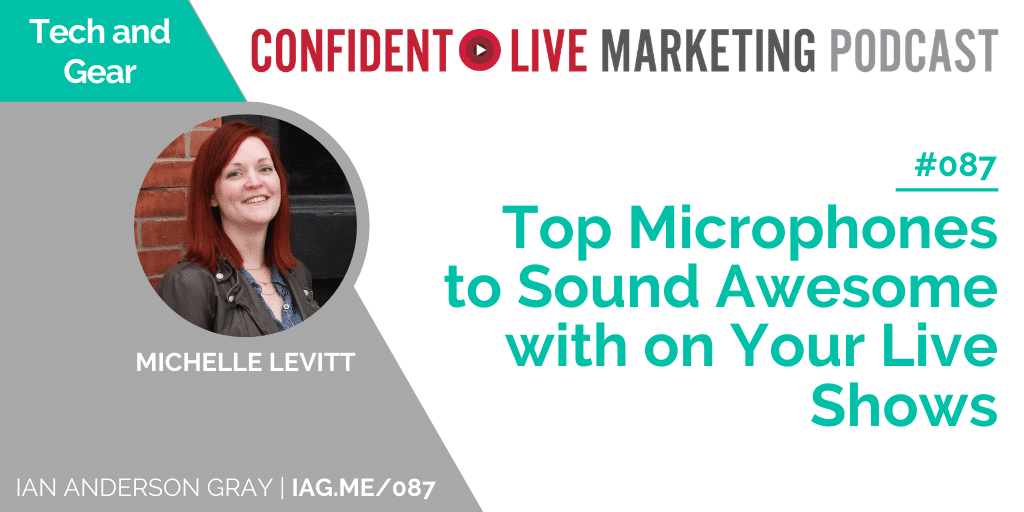Top Microphones to Sound Awesome with on Your Live Shows
Confident Live Marketing Podcast
Episode 87
Episode Theme: Tech & Gear
December 18, 2020

Do you want to sound fantastic on your live shows?
Me too…and to get that ‘radio’ quality, I swear by my Heil PR-40 microphone (together with my DBX 286S). So naturally I jumped at the chance to have a chat with Michelle Levitt, Creative Marketing Director for Heil Sound, about all things audio.
Here, Michelle and I geek out on the best microphones (and other audio equipment) for your live shows as well as ways to improve your audio quality.
What You’ll Learn
- [9:40] About Michelle’s musical background
- [11:25] Why sometimes choosing a mic you like is about knowing what you don’t like
- [12:05] Why the right microphone is so important for live video
- [12:55] The main types of microphone you need to know about
- [17:15] Why you need to know about polar patterns
- [19:40] How to position your microphone
- [30:50] About Michelle’s mic of choice
- [35:30] About USB versus XLR
- [40:00] The difference between gain and volume
- [41:00] About a mic for all budgets
This episode is sponsored by Content10X and Restream
Meet Michelle
It was a real pleasure to interview Michelle because when it comes to live video, we often spend so much time worrying about visual elements that audio becomes a bit of an afterthought.
As Creative Marketing Director for Heil Sound for the last 16 years, the CEO of her own podcast studio, a musician, and an avid concert-goer, Michelle appreciates the importance of great sound.
In fact, having gone to school on a music scholarship, she’s been using microphones in one capacity or another for about 25 years. In that time she’s experimented with a tonne of different brands and different applications so she definitely has the skinny on what you should use, where you should use it, and why you should use it.
"And that’s really important when you’re talking about microphones because, believe me, if there was one microphone for every application — we would have that!"
Sometimes You Only Know What You Don’t Like
Listen at [11:25]
Of course, she wasn’t always so knowledgeable about microphones. She reminisces about meeting her husband when playing in a jazz big band:
When it comes to microphones, a lot of people don’t know what they should have, but they know what they don’t like. @heilsoundClick To Tweet"I’m a saxophone player and the one thing I understood about microphones was when I didn’t like the way they made my saxophone sound. So early on I didn’t have a lot of experience or understanding about why I should use certain kinds of microphone but I could clearly hear when there were problems.
I think a lot of people are in that position now; they maybe don’t know what they should have, but they know what they don’t like."
Why the Right Microphone Is So Important for Live Video
Listen at [12:05]
No one would question focusing on getting the right microphone for podcasting, but why is it equally important for those of you broadcasting live video?
As Michelle points out, it’s all about making sure people can hear your message clearly.
"When you go to great lengths to ensure your visual output is top-notch and crystal clear, you want the same thing for your audio. It doesn’t make sense to neglect one aspect or the other.
You want the whole package to look really professional."
The Main Types of Microphone You Need to Know About
Listen at [12:55]
For live streaming or podcasting, Michelle reckons there are two types of microphones you need to consider: dynamic and condenser microphones.
Dynamic Microphones
Dynamic mics have fabric membrane and work in much the same way as a speaker does.
"If you’ve ever taken the cover off a speaker cabinet and you see that cone in the middle, that’s essentially a gigantic diaphragm. The speaker works by taking a signal and turning it into audio and the dynamic microphone works by taking audio and turning it into a signal, it just works in reverse. So, if you were to remove the cap from your mic, you’ll see the diaphragm inside.
Dynamic mics tend to reject audio from the back and the sides of the microphone so they don’t pick up a lot (like the cat at the door, my one-year-old downstairs, or the landscapers working on my garden!)."
The flip side of that is that you do have to talk up close to them and they’re going to be in shot. And while there are ways to ensure they’re not completely in your face, having to keep your dynamic mic in close proximity is a factor to consider when choosing the right mic for you.
Condenser Microphones
"A condenser microphone has a powered metal plate inside it, and it’s flat, so it’s designed to pick up all sorts of sound in a very detailed way. It’s really great as a room mic; you’d use it if you wanted to shoot a movie, or if you wanted to pick up crowd noise if you were shooting a live concert.
So one of the things I always tell people is that you have to get the right microphone for your application.
For example, if you’re going to use a room mic to record a video, you need to do some sort of sound treatment. You want to make sure that you don’t have a loud outdoor environment."
Why You Need to Know About Polar Patterns
Listen at [17:15]
Shotgun mics are another option that I see quite a lot of people using these days so I’m keen to get Michelle’s take on these.
"Shotgun mics are condenser microphones. And they’re great mics to talk about because they bring up the topic of polar patterns. Polar patterns are the area of which a microphone picks up audio.
A shotgun mic is designed to pick up audio that’s way out in front of the microphone so it’s polar pattern is like a really skinny oval. Whatever you point it at…that’s what it’s going to pick up. The catch is any sound that enters that laser beam of audio, is also going to be picked up.
So if you’re shooting a movie and you want the sound of say, a coffee cup being set down, that’s a good idea because you’re going to get all of that ambient sound as well."
A lav mic is another option to consider.
"That’s what we call an omni-directional microphone because it picks up audio from pretty much all around the microphone. It’s great for getting nice, even audio if you’re someone that moves your face a lot while you’re talking."
Admittedly, we’re getting into technical concepts here but, as Michelle points out, having a little bit of this technical knowledge can really help you choose the right mic for your application. It’s also important to consider your character and personality.
Think about whether you’re the kind of person that moves around a lot, or whether you’ll be giving demonstrations in your videos and might not be able to keep your microphone close to your face at all times.
Positioning Your Microphone
Listen at [19:40]
Michelle always wants her videos to look as clean and professional as possible, so her preferred setup involves a Heil PL2T boom arm with a channel cover that allows her to thread the mic cable right the way down and snap it all into place really easily.
For her hand-held mic, she likes to use a shorter, collapsible boom arm, which acts more like a mic stand. However, because there’s nowhere to hide the cable, Michelle prefers this option for podcast recording rather than video.
Michelle also swears by her professional-level broadcast shock mount to reduce the vibrations of any noise that might travel up the boom arm such as the tapping of keyboard keys or shuffling papers on the desk.
Whatever you’re looking for from a boom arm (or any other equipment), Michelle recommends checking the spec thoroughly before you buy. Yes, there’ll be a lot of technical info to sift through but, as she says, ‘that’s what Google is for!’
Michelle’s Mic of Choice
Listen at [30:50]
Michelle’s favourite mic is the PR-30:
"When I’m doing live shows, or especially when I record podcasts, I want to sound just like me. So when you meet me in person — at Podcast Movement or Podcast Fest, or whatever — I don’t sound ‘off’".
So her goal for her audio is always to sound as much like herself as possible and that comes down to the mic’s frequency response:
"Every microphone has a frequency response. That describes the range of frequencies a particular microphone can capture. Frequency responses are tailored and what that means is there’s usually a little bump in the frequency response in the 2-5 kilohertz range.
So when you look at a frequency response on a manufacturers guide you should be looking for a little rise in the response in that area. That means the microphone is going to sound really articulate on the human voice."
As Michelle explains, every microphone has a unique frequency response and the PR-30 has a little more mid-range presence than the PR-40 (my favourite!), which works better with her voice and makes her sound more natural, exactly what she’s aiming for.
I absolutely love this because, as you know, I talk a lot about authenticity in live video and that’s just another layer to add to the equation. And it highlights another point: we often think that we need to amplify the bass to achieve that punchy ‘radio’ sound but there are other ways of doing things, like going for a more realistic quality.
That’s why trying out different mics, if you can, to determine the best option for you, is often the best way forward.
Michelle agrees:
If you have the opportunity, try a couple of different mics, try them with your setup, with your voice, to see what works. @heilsoundClick To Tweet"If you have the opportunity, try a couple of different mics, try them with your setup, with your voice, to see what works. It’s like buying shoes; we might wear the same shoe size but it doesn’t mean that the same shoes will fit us all the same way."
USB or XLR?
Listen at [35:30]
"There are some dynamic mics that are USB but not many because the tech isn’t quite there yet. It’s definitely something I’m sure all of us microphone manufacturers are working on.
So most of the time, USB mics are going to be condenser microphones because it’s such an easy format for a condenser microphone.
Condenser mics need a power source. Now, this isn’t like a power supply you have to plug in like your video camera. It actually runs through the mic cable and is called phantom power. So when you have a USB mic, you plug it into your computer and the computer provides the phantom power, you don’t have to use a mixer or anything like that.
However, you are going to run into some of those typical condenser issues; it’s going to pick up a whole lot of audio so you might have to turn off your heating or your air conditioning for example."
With an XLR, on the other hand, you’re going to have to get some extra gear, such as mixers, to connect everything up.
Michelle used a 4-channel mixer during our broadcast because she was all set up for Podcast Movement, during which she’d be demoing different mics. She also recommends using a mixer if you’re in a situation where you have audio coming from multiple sources, such as from a host and co-host, so each person has their own mic channel and audio levels.
However, she usually prefers a Focusrite audio interface because she likes a simple setup;
"I don’t want to have this great big box on my desk. I want something streamlined that I can just push out of the way when I’m not using it.
There are a lot of simple interface boxes or mixers you can get that don’t cost a lot of money and are really easy to use."
Remember: Gain Is Not Volume
Listen at [40:00]
An important tip from Michelle for those of you using a mixer: gain is not volume.
She says this is something she addresses often with podcasters:
"Gain can get really nasty if you don’t know what you’re doing. So don’t turn your gain up when what you want to turn up is your volume.
For example, if you’re struggling to hear yourself, instead of cranking up the gain and getting all of that room noise, keep it 50 – 60% and change that line level. That’s one of the things you can do with a simple mixer. If you realise you’re being more animated than you’d practiced, you can tweak that stuff on the fly."
A Mic for All Budgets
Listen at [41:00]
Before signing off, I asked Michelle for her top mic picks for those of you on a budget and for those of you who don’t mind splashing out.
If you’re recording at home, Michelle recommends a dynamic mic. She reckons that the inevitable problems you’ll encounter with a condenser mic means you’re better off just going for a dynamic plus a simple mixer straight off the bat, rather than buying a condenser and having to replace it further down the line.
If you’re worried about the cost, a Heil PR-22 is a great place to start. It retails at around $120 and is hand-held so great if you might want to go out and film remotely at any point. They’re really durable so throwing it into your luggage won’t be a problem.
At the other end of the scale (but still pretty reasonable) you have the PR-30, which you can buy for around $250 and the PR-40 for a little over $300. And it’s always worth checking retailers for special offers and bundles that make everything that bit more affordable.
Resources
This Episode's Sponsors
This episode is sponsored by Content10X and Restream
Watch Episode 87
Restream
Restream is the complete multi-streaming suite for entrepreneurs.
With Restream you can stream to multiple platforms all at the same time. They have a plethora of destinations including:
- LinkedIn Live
- Facebook Live
- YouTube Live
- Twitch
- Periscope and so much more
You can stream from another tool to Restream and Restream will take care of the multi-streaming for you really easily. Or you can broadcast directly from Restream to your platform of choice.
Restream also has chat, analytics and a scheduler. With the chat service you can view and engage with your audience from all the destinations you stream to.
I've been really blown away by the Analytics section - this shows your stream metrics - now many viewers, watched minutes, new followers and more.
And finally, the scheduler allows you to broadcast pre-recorded video live.
To sign up and have a play, visit iag.me/restream
Content10X
Do you want to find ways to create more content?
You won’t after you meet the team at Content 10x!
My friends at Content 10x are a specialist content repurposing agency, they can take one live-stream, or a blog post, podcast, or video, and explode it into a plethora of new platform-specific, on-brand content..
If they don’t do all of this for you via their service, they teach you how with their podcast, blog, book and toolkit!
They’re smart, responsive, creative, and effective. If you want to take the stress out of content marketing, Content 10x are the people you want to go to.
Visit www.content10x.com to find out more.

Who is Michelle Levitt?
Michelle is the Creative Marketing Director for Heil Sound. She has also been a musician, an artist, and the CEO of her own podcast studio. When Michelle isn't working she loves going to concerts.





Comments